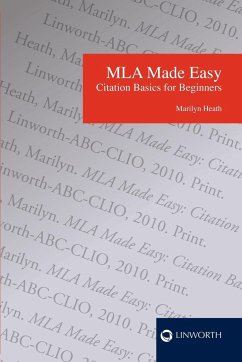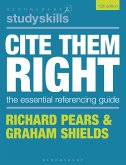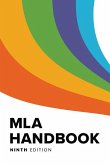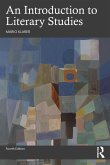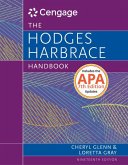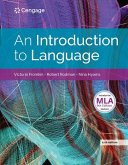- Broschiertes Buch
- Merkliste
- Auf die Merkliste
- Bewerten Bewerten
- Teilen
- Produkt teilen
- Produkterinnerung
- Produkterinnerung
A concise, handy guidebook for teaching correct MLA-style citation to middle and high school researchers. MLA Made Easy: Citation Basics for Beginners offers an effective way to introduce proper research citing to those who are new to research and the MLA style.
Andere Kunden interessierten sich auch für
![Cite Them Right Cite Them Right]() Richard Pears (Durham University)Cite Them Right15,99 €
Richard Pears (Durham University)Cite Them Right15,99 €![MLA Handbook (Official) MLA Handbook (Official)]() The Modern Language Association of AmericaMLA Handbook (Official)61,99 €
The Modern Language Association of AmericaMLA Handbook (Official)61,99 €![Cases in Haematology Cases in Haematology]() Aaron NiblockCases in Haematology41,99 €
Aaron NiblockCases in Haematology41,99 €![An Introduction to Literary Studies An Introduction to Literary Studies]() Mario KlarerAn Introduction to Literary Studies60,99 €
Mario KlarerAn Introduction to Literary Studies60,99 €![Hodges Harbrace Handbook, 2016 MLA Update Hodges Harbrace Handbook, 2016 MLA Update]() Cheryl Glenn (The Pennsylvania State University)Hodges Harbrace Handbook, 2016 MLA Update148,99 €
Cheryl Glenn (The Pennsylvania State University)Hodges Harbrace Handbook, 2016 MLA Update148,99 €![An Introduction to Language (with 2021 MLA Update Card) An Introduction to Language (with 2021 MLA Update Card)]() Victoria FromkinAn Introduction to Language (with 2021 MLA Update Card)206,99 €
Victoria FromkinAn Introduction to Language (with 2021 MLA Update Card)206,99 €![Europe and Japan Cooperation in the Fight against Cross-border Crime Europe and Japan Cooperation in the Fight against Cross-border Crime]() Europe and Japan Cooperation in the Fight against Cross-border Crime59,99 €
Europe and Japan Cooperation in the Fight against Cross-border Crime59,99 €-
-
-
A concise, handy guidebook for teaching correct MLA-style citation to middle and high school researchers. MLA Made Easy: Citation Basics for Beginners offers an effective way to introduce proper research citing to those who are new to research and the MLA style.
Hinweis: Dieser Artikel kann nur an eine deutsche Lieferadresse ausgeliefert werden.
Hinweis: Dieser Artikel kann nur an eine deutsche Lieferadresse ausgeliefert werden.
Produktdetails
- Produktdetails
- Verlag: Bloomsbury Publishing Plc
- Seitenzahl: 234
- Erscheinungstermin: 1. Dezember 2009
- Englisch
- Abmessung: 229mm x 152mm x 14mm
- Gewicht: 362g
- ISBN-13: 9781586833435
- ISBN-10: 158683343X
- Artikelnr.: 27430100
- Herstellerkennzeichnung
- Libri GmbH
- Europaallee 1
- 36244 Bad Hersfeld
- gpsr@libri.de
- Verlag: Bloomsbury Publishing Plc
- Seitenzahl: 234
- Erscheinungstermin: 1. Dezember 2009
- Englisch
- Abmessung: 229mm x 152mm x 14mm
- Gewicht: 362g
- ISBN-13: 9781586833435
- ISBN-10: 158683343X
- Artikelnr.: 27430100
- Herstellerkennzeichnung
- Libri GmbH
- Europaallee 1
- 36244 Bad Hersfeld
- gpsr@libri.de
Marilyn Heath
Table of Figures
Acknowledgments
About the Author
Introduction: Getting Ready to Cite
MLA Style
Contents and Organization
PART I: UNDERSTANDING AND CREATING MLA CITATIONS
Chapter One: Research without Plagiarism
Teaching Plagiarism
Engaging Research
Research Skills
Chapter Two: Understanding MLA Citations
Guidelines for Creating Citations
Punctuation and Formatting
Citation for a Book
Citation for a Magazine Article
Citation for a Web Page
Why Not Software?
Chapter Three: Citations for Books
The Difference between an Author and an Editor
A Citation for a Book by an Author
Who Wrote the Information Used?
What Did the Author Write?
How Was It Published?
A Citation for a Book with an Editor
Who Wrote the Information Used?
What Did the Author Write?
Where Is the Piece Found?
How Was It Published?
Citations for Multivolume Reference Sets
Exceptions to the Rule: Encyclopedias and Dictionaries
Chapter Four: Citations for Articles in Magazines, Journals, and Newspapers
Magazines
Journals
Newspapers
Chapter Five: Citing Information from Online Sources
Citing Online Sources
Information on the Web
A Scholarly Journal
Information on the Web in an Online Database
E-mail
Chapter Six: Citations for Miscellaneous Sources
PART II: PARENTHETICAL DOCUMENTATION
Chapter Seven: Summarizing, Paraphrasing, and Quoting
Summarizing
Paraphrasing
Quoting
What Teachers and Media Specialists Can Do
Chapter Eight: Parenthetical Documentation
Accuracy
Readability
PART III: FORMATTING
Chapter Nine: The Works Cited Page
Chapter Ten: Formatting a Paper in MLA Format
Formatting the Paper in Microsoft Word '97 or 2003
Formatting the Paper in Microsoft Word 2007
Common Formatting Mistakes
Citation Basics Quick Facts
Appendix A: Examples of Citations for Books
Appendix B: Examples of Citations for Periodicals
Appendix C: Examples of Citations for Computer Sources
Appendix D: Examples of Citations for Miscellaneous Sources
Appendix E: Works Cited Templates
Appendix F: Teaching Activities
Works Cited
Index
Acknowledgments
About the Author
Introduction: Getting Ready to Cite
MLA Style
Contents and Organization
PART I: UNDERSTANDING AND CREATING MLA CITATIONS
Chapter One: Research without Plagiarism
Teaching Plagiarism
Engaging Research
Research Skills
Chapter Two: Understanding MLA Citations
Guidelines for Creating Citations
Punctuation and Formatting
Citation for a Book
Citation for a Magazine Article
Citation for a Web Page
Why Not Software?
Chapter Three: Citations for Books
The Difference between an Author and an Editor
A Citation for a Book by an Author
Who Wrote the Information Used?
What Did the Author Write?
How Was It Published?
A Citation for a Book with an Editor
Who Wrote the Information Used?
What Did the Author Write?
Where Is the Piece Found?
How Was It Published?
Citations for Multivolume Reference Sets
Exceptions to the Rule: Encyclopedias and Dictionaries
Chapter Four: Citations for Articles in Magazines, Journals, and Newspapers
Magazines
Journals
Newspapers
Chapter Five: Citing Information from Online Sources
Citing Online Sources
Information on the Web
A Scholarly Journal
Information on the Web in an Online Database
Chapter Six: Citations for Miscellaneous Sources
PART II: PARENTHETICAL DOCUMENTATION
Chapter Seven: Summarizing, Paraphrasing, and Quoting
Summarizing
Paraphrasing
Quoting
What Teachers and Media Specialists Can Do
Chapter Eight: Parenthetical Documentation
Accuracy
Readability
PART III: FORMATTING
Chapter Nine: The Works Cited Page
Chapter Ten: Formatting a Paper in MLA Format
Formatting the Paper in Microsoft Word '97 or 2003
Formatting the Paper in Microsoft Word 2007
Common Formatting Mistakes
Citation Basics Quick Facts
Appendix A: Examples of Citations for Books
Appendix B: Examples of Citations for Periodicals
Appendix C: Examples of Citations for Computer Sources
Appendix D: Examples of Citations for Miscellaneous Sources
Appendix E: Works Cited Templates
Appendix F: Teaching Activities
Works Cited
Index
Table of Figures
Acknowledgments
About the Author
Introduction: Getting Ready to Cite
MLA Style
Contents and Organization
PART I: UNDERSTANDING AND CREATING MLA CITATIONS
Chapter One: Research without Plagiarism
Teaching Plagiarism
Engaging Research
Research Skills
Chapter Two: Understanding MLA Citations
Guidelines for Creating Citations
Punctuation and Formatting
Citation for a Book
Citation for a Magazine Article
Citation for a Web Page
Why Not Software?
Chapter Three: Citations for Books
The Difference between an Author and an Editor
A Citation for a Book by an Author
Who Wrote the Information Used?
What Did the Author Write?
How Was It Published?
A Citation for a Book with an Editor
Who Wrote the Information Used?
What Did the Author Write?
Where Is the Piece Found?
How Was It Published?
Citations for Multivolume Reference Sets
Exceptions to the Rule: Encyclopedias and Dictionaries
Chapter Four: Citations for Articles in Magazines, Journals, and Newspapers
Magazines
Journals
Newspapers
Chapter Five: Citing Information from Online Sources
Citing Online Sources
Information on the Web
A Scholarly Journal
Information on the Web in an Online Database
E-mail
Chapter Six: Citations for Miscellaneous Sources
PART II: PARENTHETICAL DOCUMENTATION
Chapter Seven: Summarizing, Paraphrasing, and Quoting
Summarizing
Paraphrasing
Quoting
What Teachers and Media Specialists Can Do
Chapter Eight: Parenthetical Documentation
Accuracy
Readability
PART III: FORMATTING
Chapter Nine: The Works Cited Page
Chapter Ten: Formatting a Paper in MLA Format
Formatting the Paper in Microsoft Word '97 or 2003
Formatting the Paper in Microsoft Word 2007
Common Formatting Mistakes
Citation Basics Quick Facts
Appendix A: Examples of Citations for Books
Appendix B: Examples of Citations for Periodicals
Appendix C: Examples of Citations for Computer Sources
Appendix D: Examples of Citations for Miscellaneous Sources
Appendix E: Works Cited Templates
Appendix F: Teaching Activities
Works Cited
Index
Acknowledgments
About the Author
Introduction: Getting Ready to Cite
MLA Style
Contents and Organization
PART I: UNDERSTANDING AND CREATING MLA CITATIONS
Chapter One: Research without Plagiarism
Teaching Plagiarism
Engaging Research
Research Skills
Chapter Two: Understanding MLA Citations
Guidelines for Creating Citations
Punctuation and Formatting
Citation for a Book
Citation for a Magazine Article
Citation for a Web Page
Why Not Software?
Chapter Three: Citations for Books
The Difference between an Author and an Editor
A Citation for a Book by an Author
Who Wrote the Information Used?
What Did the Author Write?
How Was It Published?
A Citation for a Book with an Editor
Who Wrote the Information Used?
What Did the Author Write?
Where Is the Piece Found?
How Was It Published?
Citations for Multivolume Reference Sets
Exceptions to the Rule: Encyclopedias and Dictionaries
Chapter Four: Citations for Articles in Magazines, Journals, and Newspapers
Magazines
Journals
Newspapers
Chapter Five: Citing Information from Online Sources
Citing Online Sources
Information on the Web
A Scholarly Journal
Information on the Web in an Online Database
Chapter Six: Citations for Miscellaneous Sources
PART II: PARENTHETICAL DOCUMENTATION
Chapter Seven: Summarizing, Paraphrasing, and Quoting
Summarizing
Paraphrasing
Quoting
What Teachers and Media Specialists Can Do
Chapter Eight: Parenthetical Documentation
Accuracy
Readability
PART III: FORMATTING
Chapter Nine: The Works Cited Page
Chapter Ten: Formatting a Paper in MLA Format
Formatting the Paper in Microsoft Word '97 or 2003
Formatting the Paper in Microsoft Word 2007
Common Formatting Mistakes
Citation Basics Quick Facts
Appendix A: Examples of Citations for Books
Appendix B: Examples of Citations for Periodicals
Appendix C: Examples of Citations for Computer Sources
Appendix D: Examples of Citations for Miscellaneous Sources
Appendix E: Works Cited Templates
Appendix F: Teaching Activities
Works Cited
Index

